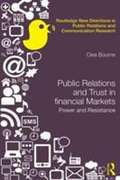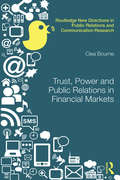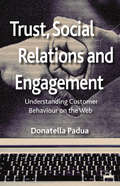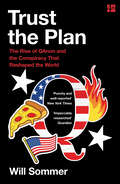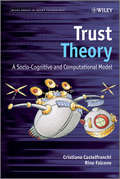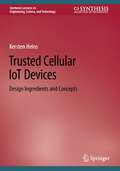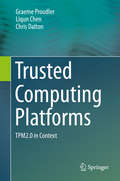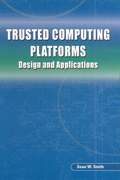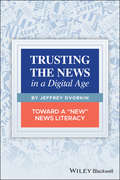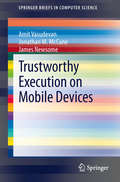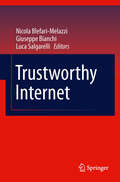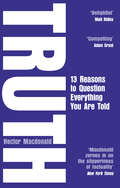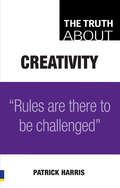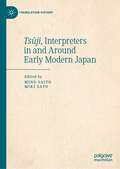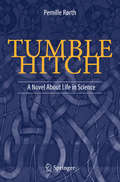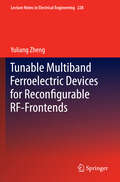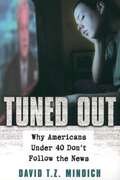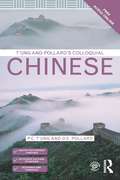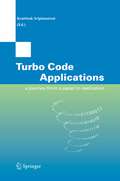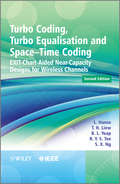- Table View
- List View
Trust, Power And Public Relations In Financial Markets
by Clea BourneThe public relations profession positions itself as expert in building trust throughout global markets, particularly after crisis strikes. Successive crises have tainted financial markets in recent years. Calls to restore trust in finance have been particularly pressing, given trust's crucial role as lubricant in global financial engines. Nonetheless, years after the global financial crisis, trust in financial markets remains both tenuous and controversial. This book explores PR in financial markets, posing a fundamental question about PR professionals as would-be 'trust strategists'. If PR promotes its expertise in building and restoring trust, how can it ignore its potential role in losing trust in the first place? Drawing on examples from state finance, international lending agencies, trade bodies, financial institutions and consumer groups in mature and emerging financial centres, this book explores the wide-ranging role of PR in financial markets
Trust, Power and Public Relations in Financial Markets (Routledge New Directions in PR & Communication Research)
by Clea BourneThe public relations profession positions itself as expert in building trust throughout global markets, particularly after crisis strikes. Successive crises have tainted financial markets in recent years. Calls to restore trust in finance have been particularly pressing, given trust’s crucial role as lubricant in global financial engines. Nonetheless, years after the global financial crisis, trust in financial markets remains both tenuous and controversial. This book explores PR in financial markets, posing a fundamental question about PR professionals as would-be ‘trust strategists’. If PR promotes its expertise in building and restoring trust, how can it ignore its potential role in losing trust in the first place? Drawing on examples from state finance, international lending agencies, trade bodies, financial institutions and consumer groups in mature and emerging financial centres, this book explores the wide-ranging role of PR in financial markets, including: State finance and debt capital markets Investor relations, M&A and IPOs Corporate communications for financial institutions Product promotion and consumer finance Financial trade associations and lobbying Consumerism and financial activism. Far reaching and challenging, this innovative book will be essential reading for researchers, advanced students and professionals in PR, communication and finance.
Trust, Power and Public Relations in Financial Markets (Routledge New Directions in PR & Communication Research)
by Clea BourneThe public relations profession positions itself as expert in building trust throughout global markets, particularly after crisis strikes. Successive crises have tainted financial markets in recent years. Calls to restore trust in finance have been particularly pressing, given trust’s crucial role as lubricant in global financial engines. Nonetheless, years after the global financial crisis, trust in financial markets remains both tenuous and controversial. This book explores PR in financial markets, posing a fundamental question about PR professionals as would-be ‘trust strategists’. If PR promotes its expertise in building and restoring trust, how can it ignore its potential role in losing trust in the first place? Drawing on examples from state finance, international lending agencies, trade bodies, financial institutions and consumer groups in mature and emerging financial centres, this book explores the wide-ranging role of PR in financial markets, including: State finance and debt capital markets Investor relations, M&A and IPOs Corporate communications for financial institutions Product promotion and consumer finance Financial trade associations and lobbying Consumerism and financial activism. Far reaching and challenging, this innovative book will be essential reading for researchers, advanced students and professionals in PR, communication and finance.
Trust, Power And Public Relations In Financial Markets (PDF)
by Clea BourneThe public relations profession positions itself as expert in building trust throughout global markets, particularly after crisis strikes. Successive crises have tainted financial markets in recent years. Calls to restore trust in finance have been particularly pressing, given trust's crucial role as lubricant in global financial engines. Nonetheless, years after the global financial crisis, trust in financial markets remains both tenuous and controversial. This book explores PR in financial markets, posing a fundamental question about PR professionals as would-be 'trust strategists'. If PR promotes its expertise in building and restoring trust, how can it ignore its potential role in losing trust in the first place? Drawing on examples from state finance, international lending agencies, trade bodies, financial institutions and consumer groups in mature and emerging financial centres, this book explores the wide-ranging role of PR in financial markets.
Trust, Social Relations and Engagement: Understanding Customer Behaviour on the Web
by D. PaduaExplains how all institutions have to turn their relationship with stakeholders into a 'social' one, which involves designing new Trust and Engagement strategies. A specific indication on how to build and measure value out of these strategies is offered by the innovative 'Value for Engagement Model'.
Trust the Plan: The Rise Of Qanon And The Conspiracy That Reshaped The World
by Will Sommer‘Detailed and impeccably researched. Eye-opening' GUARDIAN ‘Punchy and well-reported. Sommer is the perfect person to tell this story' NEW YORK TIMES
Trust Theory: A Socio-Cognitive and Computational Model (Wiley Series in Agent Technology #18)
by Christiano Castelfranchi Rino FalconeThis book provides an introduction, discussion, and formal-based modelling of trust theory and its applications in agent-based systems This book gives an accessible explanation of the importance of trust in human interaction and, in general, in autonomous cognitive agents including autonomous technologies. The authors explain the concepts of trust, and describe a principled, general theory of trust grounded on cognitive, cultural, institutional, technical, and normative solutions. This provides a strong base for the author’s discussion of role of trust in agent-based systems supporting human-computer interaction and distributed and virtual organizations or markets (multi-agent systems). Key Features: Provides an accessible introduction to trust, and its importance and applications in agent-based systems Proposes a principled, general theory of trust grounding on cognitive, cultural, institutional, technical, and normative solutions. Offers a clear, intuitive approach, and systematic integration of relevant issues Explains the dynamics of trust, and the relationship between trust and security Offers operational definitions and models directly applicable both in technical and experimental domains Includes a critical examination of trust models in economics, philosophy, psychology, sociology, and AI This book will be a valuable reference for researchers and advanced students focused on information and communication technologies (computer science, artificial intelligence, organizational sciences, and knowledge management etc.), as well as Web-site and robotics designers, and for scholars working on human, social, and cultural aspects of technology. Professionals of ecommerce systems and peer-to-peer systems will also find this text of interest.
Trusted Cellular IoT Devices: Design Ingredients and Concepts (Synthesis Lectures on Engineering, Science, and Technology)
by Kersten HeinsThis book focuses on the impact of secure frontend devices for the Internet of Things (IoT). It explains how to identify vulnerabilities of IoT applications and how to protect them against misuse and attacks. Provided insights will help readers to design a reliable and trustworthy IoT ecosystem ensuring a high level of user confidence and a fruitful deployment. As a starting point, the book provides guidance how to identify risks and potential threats. Then, it explains which countermeasures are available and introduces all major ingredients for an efficient implementation of IoT security measures, e.g. a bullet-proof protection of user privacy and device identities. The author outlines an efficient design approach that combines classical embedded computing with smartcard technology and wireless cellular networking like LTE-M or NB-IoT. The target audience includes industrial professionals and students focusing on low cost design and a fast time-to-market. The book is ideal for engineering-minded IoT project owners to safeguard their business goals.
Trusted Computing Platforms: TPM2.0 in Context
by Graeme Proudler Liqun Chen Chris DaltonIn this book the authors first describe the background of trusted platforms and trusted computing and speculate about the future. They then describe the technical features and architectures of trusted platforms from several different perspectives, finally explaining second-generation TPMs, including a technical description intended to supplement the Trusted Computing Group's TPM2 specifications. The intended audience is IT managers and engineers and graduate students in information security.
Trusted Computing Platforms: Design and Applications
by Sean W. SmithFrom early prototypes and proposed applications, this book surveys the longer history of amplifying small amounts of hardware security into broader system security Including real case study experience with security architecture and applications on multiple types of platforms. Examines the theory, design, implementation of the IBM 4758 secure coprocessor platform and discusses real case study applications that exploit the unique capabilities of this platform. Examines more recent cutting-edge experimental work in this area. Written for security architects, application designers, and the general computer scientist interested in the evolution and use of this emerging technology.
Trusting the News in a Digital Age: Toward a "New" News Literacy
by Jeffrey DvorkinHow to use critical thinking to discern real news from fake news Trusting the News in a Digital Age provides an ethical framework and the much-need tools for assessing information produced in our digital age. With the tsunami of information on social media and other venues, many have come to distrust all forms of communication including the news. This practical text offers guidance on how to use critical thinking, appropriate skepticism, and journalistic curiosity to handle this flow of undifferentiated information. Designed to encourage critical thinking, each chapter introduces specific content, followed at the end of each section with an ethical dilemma. The ideas presented are based on the author’s experiences as a teacher and public editor/ombudsman at NPR News. Trusting the News in a Digital Age prepares readers to deal with changes to news and information in the digital environment. It brings to light the fact that journalism is about treating the public as citizens first, and consumers of information second. This important text: Reveals how to use critical thinking to handle the never-ending flow of information Contains ethical dilemmas to help sharpen critical thinking skills Explains how to verify sources and spot frauds Looks at the economic and technological conditions that facilitated changes in communication Written for students of journalism and media studies, Trusting the News in the Digital Age offers guidance on how to hone critical thinking skills needed to discern fact from fiction.
Trusting the News in a Digital Age: Toward a "New" News Literacy
by Jeffrey DvorkinTRUSTING THE NEWS in a Digital Age How to use critical thinking to discern real news from fake newsTrusting the News in a Digital Age provides an ethical framework and the much-needed tools for assessing information produced in our digital age. With the tsunami of information on social media and other venues, many have come to distrust all forms of communication, including the news. This practical text offers guidance on how to use critical thinking, appropriate skepticism, and journalistic curiosity to handle this flow of undifferentiated information.Designed to encourage critical thinking, each chapter introduces specific content, followed at the end of each section with an ethical dilemma. The ideas presented are based on the author’s experiences as a teacher and public editor/ombudsman at NPR News. Trusting the News in a Digital Age prepares readers to deal with changes to news and information in the digital environment. It brings to light the fact that journalism is about treating the public as citizens first, and consumers of information second. This important text:Reveals how to use critical thinking to handle the never-ending flow of informationContains ethical dilemmas to help sharpen critical thinking skillsExplains how to verify sources and spot fraudsLooks at the economic and technological conditions that facilitated changes in communicationWritten for students of journalism and media studies, Trusting the News in the Digital Age offers guidance on how to hone critical thinking skills needed to discern fact from fiction.
Trustworthy Execution on Mobile Devices (SpringerBriefs in Computer Science)
by Amit Vasudevan Jonathan M. McCune James NewsomeThis brief considers the various stakeholders in today's mobile device ecosystem, and analyzes why widely-deployed hardware security primitives on mobile device platforms are inaccessible to application developers and end-users. Existing proposals are also evaluated for leveraging such primitives, and proves that they can indeed strengthen the security properties available to applications and users, without reducing the properties currently enjoyed by OEMs and network carriers. Finally, this brief makes recommendations for future research that may yield practical and deployable results.
Trustworthy Internet
by Luca Salgarelli, Giuseppe Bianchi and Nicola Blefari-MelazziThis book collects a selection of the papers presented at the 21st International Tyrrhenian Workshop on Digital Communications, organized by CNIT and dedicated this year to the theme "Trustworthy Internet". The workshop provided a lively discussion on the challenges involved in reshaping the Internet into a trustworthy reality, articulated around the Internet by and for People, the Internet of Contents, the Internet of Services and the Internet of Things, supported by the Network Infrastructure foundation. The papers have been revised after the workshop to take account of feedbacks received by the audience. The book also includes: i) an introduction by the Editors, setting the scene and presenting evolution scenarios; ii) five papers written by the session chairmen, reputed scientists, and each dedicated to a facet of the trustworthy Internet vision; iii) a concluding paper, reporting the outcomes of a panel held at the conclusion of the workshop, written by the two keynote speakers.
Truth: How the Many Sides to Every Story Shape Our Reality
by Hector Macdonald'Macdonald zeros in on the slipperiness of factuality, offering an array of case studies from the worlds of history, commerce and – of course – politics.'New York Times Book ReviewFor fans of Nudge, Black Box Thinking and The Art of Thinking Clearly, a fascinating dive into the many ways in which ‘competing truths’ shape our opinions, behaviours and beliefs.True or false? It’s rarely that simple.There is more than one truth about most things. Eating meat is nutritious but it’s also damaging to the environment. The Internet disseminates knowledge but it also spreads hatred. As communicators, we select the truths that are most useful to our agenda.We can select truths constructively to inspire organisations, encourage children, and drive progressive change. Or we can select truths that give a false impression of reality, misleading people without actually lying. Others can do the same, motivating or deceiving us with the truth. Truths are neutral but can also be highly versatile tools that we can use for good or ill.Hector Macdonald here explores how truth is used and abused in politics, business, the media and everyday life. Combining great storytelling with practical takeaways and a litany of fascinating, funny and insightful case studies, Truth is a sobering and engaging read about how profoundly our mindsets and actions are influenced by the truths that those around us choose to tell.
The Truth About Creativity: Rules are there to be challenged
by Patrick HarrisThe Truth About Creativity provides a practical and example-laden journey through creativity and its talent-releasing benefits for organisations, teams and individuals. Many of the truths are new perspectives on well-known creativity topics and will teach you how to: capture and use half-thoughts in the workplace; use alternative techniques to brainstorming; realise ideas must get complex before they get profound; succeed with a £10 budget; build momentum to take people with you; test the validity of ideas with a 5 minute business plan; recognize the customer isn't always right - but listen to them anyway...and more.
The Truth About Creativity: Rules are there to be challenged
by Patrick HarrisThe Truth About Creativity provides a practical and example-laden journey through creativity and its talent-releasing benefits for organisations, teams and individuals. Many of the truths are new perspectives on well-known creativity topics and will teach you how to: capture and use half-thoughts in the workplace; use alternative techniques to brainstorming; realise ideas must get complex before they get profound; succeed with a £10 budget; build momentum to take people with you; test the validity of ideas with a 5 minute business plan; recognize the customer isn’t always right – but listen to them anyway…and more.
Tsūji, Interpreters in and Around Early Modern Japan (Translation History)
by Mino Saito Miki SatoThis book introduces English-speaking audiences to tsūji, who were interpreters in different contexts in Japan and then the Ryukyu Kingdom from the late 16th to the mid-19th century. It comprises seven historical case studies on tsūji in which contributors adopt a context-oriented approach. They aim to explore the function of these interpreters in communication with other cultures in different languages, including Japanese, Dutch, Chinese, Korean, Ryukyuan, English, Russian and Ainu. Each chapter elucidates the tsūji and the surrounding social, political and economic conditions. The book will be of interest to students and scholars of translation and interpreting, but also readers interested in the early modern history of interpreting and cultural exchange. It will similarly appeal to those interested in the Japanese language, but with limited access to books written in Japanese.
Tumble Hitch: A Novel About Life in Science
by Pernille RørthJessie Aitkin, the long-time Editor-in-Chief of a leading life sciences journal, receives a fantastic job offer. A young animal rights activist requests an interview with her husband, Peter Dahl, a research scientist at a prestigious institute. An unexpected revelation sets in motion a series of events that shifts the course of their careers and their relationship. In this novel, another page turner by the author of Raw Data: A Novel on Life in Science (Springer 2016), enthusiasm for basic research and for how science is – and could be – communicated combine in a thoughtful reflection on the impact of ambition on personal relationships. In a non-technical appendix, the author discusses the use of narrative in scientific papers and considers alternative modes of science publishing, one of which is featured in the novel. Storytelling in science has the potential to enhance communication, but may also have unintended consequences. This novel and the appendix explore these timely and important issues for the scientific community.
Tunable Multiband Ferroelectric Devices for Reconfigurable RF-Frontends (Lecture Notes in Electrical Engineering #228)
by Yuliang ZhengReconfigurable RF-frontends aim to cope with the continuous pursuit of wider frequency coverage, higher efficiency, further compactness and lower cost of ownership. They are expected to lay the foundations of future software defined or cognitive radios. As a potential enabling technology for the frontends, the tunable ferroelectric devices have shown not only enhanced performance but also new functionalities. This book explores the recent developments in the field. It provides a cross-sectional perspective on the interdisciplinary research. With attention to the devices based on ceramic thick-films and crystal thin-films, the book reviews the adapted technologies of material synthesis, film deposition and multilayer circuitry. Next, it highlights the original classes of thin-film ferroelectric devices, including stratified metal-insulator-metal varactors with suppression of acoustic resonance and programmable bi-stable high frequency capacitors. At the end the book analyzes how the frontends can be reformed by tunable multiband antennas, tunable single- and multiband impedance matching networks and tunable substrate integrated waveguide filters, which are all built on low cost ferroelectric thick-films. For all the above devices, the theoretical analyses, modeling and design methods are elaborated, while through demonstrative prototypes the application potential is evaluated.
Tuned Out: Why Americans Under 40 Don't Follow the News
by David T. MindichAt a rate never before seen in American history, young adults are abandoning traditional news media. Tuned Out: Why Americans Under 40 Don't Follow the News examines the reasons behind this problem and its consequences for American society. Author David T. Z. Mindich speaks directly to young people to discover why some tune in while others tune out--and how America might help them tune back in. Based on discussions with young adults from across the United States, Mindich investigates the decline in news consumption over the past four decades. In 1972, 74% of Americans in their mid-30s said they read a newspaper every day. Today, fewer than 28% do so. The average viewer age at CNN is currently about 60 years old. And while many point to the Internet as the best hope for rekindling interest in the news, only 11% of young people list the news as a major reason for logging on--entertainment, e-mail, and Instant Messenger are ranked far higher on their list. Exploring the political, journalistic, and social consequences of this decrease in political awareness, Mindich poses the question: What are the consequences of two successive generations tuning out? He asserts that as young adults abandon the kinds of news needed to make political decisions, they have unwittingly ceded power to their elders. In an engaged and intelligent way, Mindich outlines these problems and proposes real solutions. An indispensable resource for anyone interested in media or politics, Tuned Out: Why Americans Under 40 Don't Follow the News is also ideal for undergraduate and graduate students in journalism, media, communication, political science, American studies, sociology, and education.
T'ung & Pollard's Colloquial Chinese
by P.C. T'ung D.E. PollardT’ung and Pollard’s Colloquial Chinese course is the ideal introductory course for all dedicated learners of Mandarin Chinese. Written by experienced teachers, the course provides a rigorous introduction to the pronunciation, vocabulary and grammar of Mandarin Chinese. By the end of this rewarding course learners will be able to communicate confidently in a wide variety of situations. The solid foundation provided is also ideal for those who wish to advance their language skills to higher levels. Divided into 17 lessons, each lesson contains conversations based on common daily situations, vocabularies, grammar notes and exercises to help learn and practice basic skills. Key features include: clear grammar explanations lots of exercises for regular practice Pinyin Romanization used throughout Chinese-English glossary for quick reference. Audio material to accompany the course is available to download free in MP3 format from www.routledge.com/cw/colloquials. Recorded by native speakers, the audio material features the dialogues and texts from the book and will help develop your listening and pronunciation skills.
Turbo Code Applications: a Journey from a Paper to realization
by Keattisak SripimanwatTurbo Code Applications: a journey from a paper to realization presents c- temporary applications of turbo codes in thirteen technical chapters. Each chapter focuses on a particular communication technology utilizing turbo codes, and they are written by experts who have been working in related th areas from around the world. This book is published to celebrate the 10 year anniversary of turbo codes invention by Claude Berrou Alain Glavieux and Punya Thitimajshima (1993-2003). As known for more than a decade, turbo code is the astonishing error control coding scheme which its perf- mance closes to the Shannon’s limit. It has been honored consequently as one of the seventeen great innovations during the ?rst ?fty years of information theory foundation. With the amazing performance compared to that of other existing codes, turbo codes have been adopted into many communication s- tems and incorporated with various modern industrial standards. Numerous research works have been reported from universities and advance companies worldwide. Evidently, it has successfully revolutionized the digital commu- cations. Turbo code and its successors have been applied in most communications startingfromthegroundorterrestrialsystemsofdatastorage,ADSLmodem, and ?ber optic communications. Subsequently, it moves up to the air channel applications by employing to wireless communication systems, and then ?ies up to the space by using in digital video broadcasting and satellite com- nications. Undoubtedly, with the excellent error correction potential, it has been selected to support data transmission in space exploring system as well.
Turbo Coding, Turbo Equalisation and Space-Time Coding: EXIT-Chart-Aided Near-Capacity Designs for Wireless Channels (Wiley - IEEE #22)
by Lajos Hanzo T. H. Liew B. L. Yeap R. Y. Tee Soon Xin NgCovering the full range of channel codes from the most conventional through to the most advanced, the second edition of Turbo Coding, Turbo Equalisation and Space-Time Coding is a self-contained reference on channel coding for wireless channels. The book commences with a historical perspective on the topic, which leads to two basic component codes, convolutional and block codes. It then moves on to turbo codes which exploit iterative decoding by using algorithms, such as the Maximum-A-Posteriori (MAP), Log-MAP and Soft Output Viterbi Algorithm (SOVA), comparing their performance. It also compares Trellis Coded Modulation (TCM), Turbo Trellis Coded Modulation (TTCM), Bit-Interleaved Coded Modulation (BICM) and Iterative BICM (BICM-ID) under various channel conditions. The horizon of the content is then extended to incorporate topics which have found their way into diverse standard systems. These include space-time block and trellis codes, as well as other Multiple-Input Multiple-Output (MIMO) schemes and near-instantaneously Adaptive Quadrature Amplitude Modulation (AQAM). The book also elaborates on turbo equalisation by providing a detailed portrayal of recent advances in partial response modulation schemes using diverse channel codes. A radically new aspect for this second edition is the discussion of multi-level coding and sphere-packing schemes, Extrinsic Information Transfer (EXIT) charts, as well as an introduction to the family of Generalized Low Density Parity Check codes. This new edition includes recent advances in near-capacity turbo-transceivers as well as new sections on multi-level coding schemes and of Generalized Low Density Parity Check codes Comparatively studies diverse channel coded and turbo detected systems to give all-inclusive information for researchers, engineers and students Details EXIT-chart based irregular transceiver designs Uses rich performance comparisons as well as diverse near-capacity design examples
Turbo Coding, Turbo Equalisation and Space-Time Coding: EXIT-Chart-Aided Near-Capacity Designs for Wireless Channels (Wiley - IEEE #21)
by Lajos Hanzo T. H. Liew B. L. Yeap R. Y. Tee Soon Xin NgCovering the full range of channel codes from the most conventional through to the most advanced, the second edition of Turbo Coding, Turbo Equalisation and Space-Time Coding is a self-contained reference on channel coding for wireless channels. The book commences with a historical perspective on the topic, which leads to two basic component codes, convolutional and block codes. It then moves on to turbo codes which exploit iterative decoding by using algorithms, such as the Maximum-A-Posteriori (MAP), Log-MAP and Soft Output Viterbi Algorithm (SOVA), comparing their performance. It also compares Trellis Coded Modulation (TCM), Turbo Trellis Coded Modulation (TTCM), Bit-Interleaved Coded Modulation (BICM) and Iterative BICM (BICM-ID) under various channel conditions. The horizon of the content is then extended to incorporate topics which have found their way into diverse standard systems. These include space-time block and trellis codes, as well as other Multiple-Input Multiple-Output (MIMO) schemes and near-instantaneously Adaptive Quadrature Amplitude Modulation (AQAM). The book also elaborates on turbo equalisation by providing a detailed portrayal of recent advances in partial response modulation schemes using diverse channel codes. A radically new aspect for this second edition is the discussion of multi-level coding and sphere-packing schemes, Extrinsic Information Transfer (EXIT) charts, as well as an introduction to the family of Generalized Low Density Parity Check codes. This new edition includes recent advances in near-capacity turbo-transceivers as well as new sections on multi-level coding schemes and of Generalized Low Density Parity Check codes Comparatively studies diverse channel coded and turbo detected systems to give all-inclusive information for researchers, engineers and students Details EXIT-chart based irregular transceiver designs Uses rich performance comparisons as well as diverse near-capacity design examples
